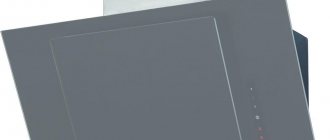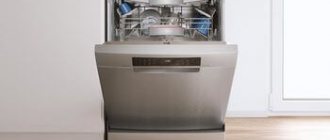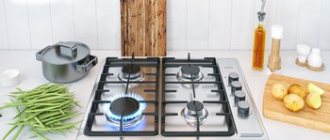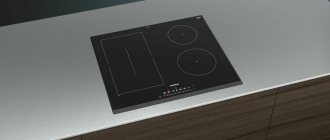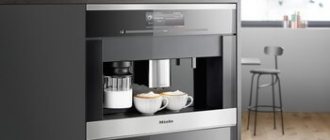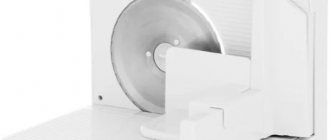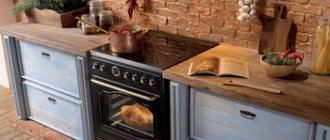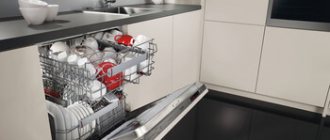If you love to cook, then a range hood is the kitchen appliance that you shouldn’t skimp on. There are several reasons for this. Firstly, built-in hoods, while remaining almost invisible, allow you to avoid the appearance of dirt on walls, ceilings, doors and other surfaces. Secondly, they quickly remove all unpleasant odors, especially if something is burnt on your hob.
The hood prevents the odors emitted by the stove from penetrating into neighboring rooms, as well as from permeating the clothes and hair of those present.
Types of hoods
Hoods can be industrial or domestic. Industrial ones are larger in size and are installed in food production facilities, restaurants, and canteens. Household ones are preferred for the home as their capabilities are limited.
Types of household models by installation type:
- Fireplace (dome) - so called because of their similarity to a conventional fireplace system. The principle of their operation boils down to the following - air enters the dome-shaped housing and is discharged through the air duct into the ventilation. Fireplace designs most often have a bright design and are distinguished by expensive finishes. And they need to be selected even before the kitchen is equipped with appliances. Depending on the location, there are wall, island and corner fireplace hoods.
- Suspended - their working area is equal to the area of the hob. They are characterized by a small height, which is why they are also called “flat”. They are mounted under the kitchen cabinet and flush with the adjacent ones so that their lower parts are in line. Such models are the most budget-friendly of all that are presented on the market.
- Built-in - they operate in flow mode, and therefore require an air duct. They can be mounted in the ceiling, in a table, in a closet so that only that part of the structure that absorbs air remains visible. Based on the type of installation in the cabinet, built-in appliances are divided into pull-out and fully built-in. The retractable one has a small panel that slides out and increases the fence area. Fully recessed is installed completely, without leaving visible elements. Ceiling - designed for installation in a niche, which is created by installing plasterboard slabs on the ceiling. Ceiling units are good because they are inconspicuous and take up minimal space.
Advantages of built-in hoods
Many people underestimate the importance of ventilation in the kitchen, neglecting the purchase. In fact, this is a common mistake, because a high-quality hood extends the service life of the kitchen, walls and household appliances. Built-in models were created specifically for small spaces where every square meter is valuable.
You may be interested in: Rating of the 7 best chest freezers for the home: which one to buy, comparison of models, reviews
The models have many advantages, among the most significant are:
- Appearance. Many hoods are equipped with a retractable design. When retracted they are not noticeable. The overall interior of the kitchen will not be spoiled.
- Space saving. Just like any built-in appliance, this one is small in size and takes up minimal space.
- Volume and power consumption. The smaller the device, the less electricity it consumes.
Many housewives dream of buying a built-in hood, and this is not surprising, because they have many advantages.
Difference from suspended
Built-in hood or hanging hood, which is better? The second option is more common in modern kitchens. The popularity of the model is explained by its quality and cost. Installed above the stove, at a distance depending on the type of oven.
A cabinet can be located above such a device. Classic units are cumbersome and almost impossible to hide from prying eyes. But if the style matches the kitchen, then you can play it as if it were a separate piece of furniture.
It is much more convenient to embed models, because in this case it is possible to achieve almost complete camouflage. All that remains visible is the surface. This option is reliable and attractive.
From dome
A dome hood is a flow-type model that resembles a dome. The appearance resembles a chimney from a fireplace, which is why it is called fireplace. The main advantage is that a correctly selected device becomes a decoration of the kitchen. However, there is a drawback - it can only be combined with retro or classic style.
Manufacturers are improving the models; today they are presented in different colors and textures.
When talking about whether a built-in hood or a dome hood is better, it is impossible to give an exact answer. It all depends on the taste and needs of buyers. Each model has a specific set of functions and is presented in different price categories.
From oblique
The main feature of an inclined hood is its location and design. The panel is at an angle to the hob, which makes it convenient to use: you won’t have to hit your head.
The panel is compact, the surface is glossy. The advantages lie not only in a presentable appearance, but also in convenient management. There is a touch module, a remote control, and voice is perceived. As for horizontal hoods, they are less convenient and have poor functionality.
If the question arises: a built-in model or an inclined one, then first of all you need to decide what you are looking for: decorating the kitchen or hiding it from view.
Criterias of choice
- Exhaust power. The volume of air that it can remove (or purify) per unit of time depends on the power of the hood. The calculation will be simple: according to sanitary standards, the hood must extract at least 10-12 m³/h. We calculate the volume of the kitchen space, multiply by 12, add a “reserve” of 20 percent and another 5%-10% if the kitchen uses gas rather than electricity - and we get what we are looking for. If you want to save money, you can subtract the volume occupied by furniture and a refrigerator. For example, a kitchen with an area of 10 square meters and a ceiling height of 3.2 meters will require a hood with a capacity of about 500 m³/h. Most hoods have several operating modes, which allows you to regulate the speed of the motor, and at the same time the volume of air passing through the device (and at the same time the noise level).
- Principle of operation. Recirculation without duct or exhaust with duct:
Circulation hood. This device received this name because it simply forces air to circulate throughout the room, eliminating foreign odors by passing it through a carbon filter, which is located inside the hood itself. In addition to the carbon filter, this hood is equipped with grease traps. The principle of its operation determines all the positive and negative aspects of such a design.
Pros of circulation hoods
- Possibility of use in houses with a clogged ventilation system or simply designed for low draft and cannot cope with the capabilities of modern hoods.
- Such a device can be placed anywhere and you do not have to pull the corrugation from the ventilation shaft to it. This also opens up wide possibilities for designers - such a hood can be hidden in a countertop or behind a false wall.
- When recirculating air, it is not necessary to create strong draft, which means the devices can be more compact and more economical in terms of energy consumption.
- With less load on the engine, which is the main component of the hood, the overall service life of the device increases.
- The location of the cooking plate is not tied to the ventilation shaft.
Disadvantages of circulation hoods
- The need to purchase consumables - depending on the intensity of use of the hood, carbon filters must be changed approximately every six months to a year.
- You will have to regularly wash the grease filter - it is a fine metal mesh that is installed at the bottom of the hood and cleaned in running water or in the dishwasher.
- There is no point in placing a circulation hood over a gas stove. During the combustion of gas, oxygen from the air is converted into carbon monoxide (CO²), which the hood will simply circulate around the kitchen. Recycling in this case becomes not only ineffective, but also hazardous to health.
Flow hood. The main difference of such a device is that for it to work effectively it definitely needs access to the ventilation shaft. The hood is mounted either directly next to its opening, or is connected to it with a corrugated pipe, which is made as short as possible - the smaller it is, the quieter the operation of the hood. For this reason, devices of this type are somewhat limited in their installation location - on the wall above the stove or on the ceiling. The principle of operation of the device is quite simple. The fan pumps air and draws it out of the room, forming a kind of draft that forms when the window is open, only the air does not spin around the kitchen, but is blown by the fan into the ventilation shaft or directly outside if a separate ventilation hole is made in the kitchen wall for the hood. Since dirty air is discharged outside, there is no need to use carbon filters, but to prevent particles of fat and soot from contaminating the insides of the hood itself, a grease filter is still installed on it. It must be washed periodically - the cleanliness of this part determines how efficiently and quietly the hood will work. Due to the need to install ventilation, it is better to install flow hoods during renovation work in the kitchen and, when planning it, separately calculate its location. Particular attention should be paid to the air duct - ideally it should be a straight line without bends or turns. If they are present, the air will hum strongly inside the pipe and using the hood will be at least uncomfortable. In general, based on the principle of operation, it is clear which hood for a gas stove is better - in this case, only a flow-through one should be installed. Almost all models of flow hoods can be started in recirculation mode - for this, a carbon filter is installed at the outlet and the device is ready for operation.
Advantages of flow hood
- The ability to make powerful, high-performance devices.
- There are no consumables that need systematic replacement - the grease filters used are almost eternal.
- The hood can be hidden in the kitchen furniture.
- The noise level is lower than that of circulating analogues.
Disadvantages of flow hood
- Since the hood essentially pumps air out of the kitchen, another must flow in its place, for which you need to leave the window open or think about ventilation also for air flow.
- A consequence of the previous drawback is that in winter the hood removes warm air from the room, replacing it with cold air, and in summer, vice versa.
- If the stove is (or will be installed) far from the ventilation hole, large-scale installation work is inevitable.
- Case design and material. The choice of the appearance of the hood is determined by two factors: the attractiveness of the design and ease of maintenance (everyday cleaning). There are many models on the market, so there is no doubt that every cook will be able to choose just the right hood that will look great in his kitchen. But cleaning can be difficult. Therefore, it is better not to choose hoods whose body is made of cheap heat-resistant plastic, and opt for enameled, or better yet, metal bodies, which will be more durable and easier to clean. The alternative in the form of tempered glass is visually attractive, but it is an expensive solution and not very convenient for everyday care.
- Dimensions. The value should be selected based on the dimensions of the hob. It is the width that determines how well the fumes generated from cooking will be captured. The dimensions of the hood should be slightly larger than the dimensions of the panel. On the market you can find devices with a width of 50 to 90 cm. Models with a side of 60 cm are standard and universal. They are suitable for most gas stoves and electric surfaces. The depth depends on the parameters of the furniture in which the device is mounted. There are several solutions.
- Narrow appliances with a retractable panel that increases coverage area.
- The device is equal in depth to the headset.
- An option with a depth less than that of a cabinet.
In kitchens where cooking is frequent and varied, the use of the first group of devices is more appropriate. But the second and third types are more appropriate if the process of cooking occurs periodically. If you install a copy that is smaller than necessary, then you will face negative consequences:
- the unit will not cope 100% with its task, and some of the odors and fumes will enter the living rooms;
- Oily deposits and moisture will settle on nearby walls, which can cause the furniture to change color and swell.
- Noise level. If you conduct a survey among housewives what they don’t like about the hood, then the majority, I’m sure, will answer – noise. A monotonous and loud hum is very annoying, so you need to pay special attention to this characteristic. The noise level directly depends on the throughput: the more powerful the unit, the louder it makes noise. The noise level should be no higher than 55 dB at “low” speed. In intensive mode, the volume can reach 60-65 dB, which is considered quite acceptable. After all, you need to turn on enhanced cleansing for a short time, so you can be patient for a little while. Higher values will no longer be comfortable. In addition, such volume causes vibrations that spread throughout the kitchen furniture.
- Control. The hood control can be mechanical or electronic (for example, touch). In the first case, switching operating modes and lighting systems is carried out using mechanical buttons, in the second - using an electronic system, often equipped with a display indicating the selected operating mode. The main advantages of the electronic control system (in addition to aesthetic ones) are the ability to set a timer for turning the hood on and off. More advanced models can automatically change their mode depending on the degree of air pollution, and some even allow remote control via a special remote control or smartphone. The need for the presence or absence of such functions remains at the discretion of the buyer. Additional (optional) modes include an intensive mode, in which the hood operates at maximum power for some time, after which it switches to one of the standard modes, and an interval mode, which involves periodically turning on the hood for a predetermined time. The controls for most hoods remain standard - understandable even to an inexperienced user. The lighting provided in most hoods will help illuminate the hob, and can also become an independent element of the interior. Most hoods use standard E14 bulbs, but due to the latest EU energy saving directives, all hoods will be switching to more energy efficient LED bulbs in the near future. If desired, you can choose a hood that allows you to adjust the light intensity or even allow directional lighting of a specific kitchen area. It is also worth mentioning hoods that are ready to work together with hobs. Naturally, compatibility here remains at the manufacturer level: it must be the same. Such hoods are, in fact, controlled by the hob itself: it decides which mode will be optimal at the moment, based on the use of its resources.
- Additional criteria
Automatic switching on is implemented by using special sensors that detect the start of the cooking process by monitoring temperature and humidity. When these indicators change, the sensors independently turn on the device and turn it off using the same principle.
Inclined shape - inclined devices are a type of fireplace models. Their workspace is at different angles. Thanks to their ergonomics, such units save work space and make the least noise.
Remote control – provides the ability to regulate the operation of equipment remotely, without the need to run to the control buttons every time;
Timer – allows you to set the time when you need to turn off the equipment or switch to another mode.
How to choose
There are many models from different manufacturers in stores. In order not to get confused in the choice, it is recommended to study the list of parameters that you should focus on when purchasing.
Footprint
The indicator is indicated in the product description; you do not have to take measurements yourself. It indicates the volume of air that the hood cleans in a certain period of time. The final numbers depend on the power.
It is recommended to give preference to those devices that make the air fresh in 10-15 minutes. As for the area, it should be 15-20% larger than the kitchen parameters.
Width
This is the main characteristic. Firstly, the ventilation must be wider than the hob, otherwise steam, grease, and smell will settle on the furniture and walls, leaving behind a dirty residue.
Secondly, a fully built-in hood must be measured in terms of dimensions. If there is even a centimeter difference, the vent will not be placed in the cabinet. Check the numbers several times, watch how the builders carry out the installation.
Ability to adjust power
The function is always useful, as housewives prepare different dishes. When the oil is bubbling in the frying pan, splashing in all directions and strong steam is emanating, the air purification mode should be at maximum. Conversely, when eggs are boiled in a saucepan, the work is 100% not useful.
Self-adjusting power allows you to save energy and reduce mechanical noise.
Backlight
A few years ago, the option was only available in expensive models. Nowadays the presence of lighting will not surprise anyone; it is in every second hood. Manufacturers only change the number of light bulbs and their location.
You may be interested in: TOP 7 best floor fans: which one is better to buy, reviews, characteristics, price, pros and cons
When choosing a device based on this criterion, take into account the fact how illuminated the work surface in your kitchen is. It is not necessary to overpay and purchase a hood whose power and operating power are exactly the same as that of a spotlight.
Noise level
Few people pay attention to the point, but after time it turns out that it was decisive. Hardly anyone wants to feel pressure on their eardrums, and loud noise quickly becomes boring and begins to irritate.
The noise level depends on the power. In other words, the better the ventilation, the louder the sounds will be produced during operation. Experts recommend paying attention to those models where the noise level does not exceed 55 dB.
Air purification method
You should choose a device depending on how exactly it purifies the air. There are several options:
- Retraction . Traditional suction and release into the ventilation system. This is the classic type and the most budget-friendly.
- Recirculation . The air passes through the filter, after which it is released into the room, but now clean. The cost of the device is more expensive, and the price is reflected during operation. The whole problem is the filters, which have to be changed frequently.
When purchasing a hood for an apartment, pay attention to its quality, performance, and method of operation.
Other features
There are many minor options that will be a pleasant addition to the existing functionality:
- Removable front panel - makes it possible to hide the device from prying eyes.
- Filters for cleaning. They can only be selected for the recirculation type.
- Automation. Expensive models have entire systems. It seems that they are built from little things, but they are the ones who make a person’s life easier. This could be automatic switching on, lighting triggering when you approach, etc.
A hood built into a kitchen cabinet is by far the best. It has many useful characteristics and is reasonably priced.
The best manufacturers of built-in hoods
- Elikor. A domestic company founded more than 20 years ago - in 1995 - specializes exclusively in kitchen hoods. Its assortment includes a large number of models for kitchens of various styles. According to company representatives, at the moment, every fifth hood sold in Russia has come off the ELIKOR assembly line.
- Jetair . The company, founded in the small Italian town of Ceretto in 1984, was one of the first to specialize in hoods. To date, the company is one of the leaders in this market, offering customers not only good quality, but also famous Italian design.
- Kronasteel . The German company, founded in 2001, is one of the youngest, but at the same time the most successful, judging by sales in recent years. Despite its European origin, the target market is Russia and the CIS countries. The high popularity is due to the large number of models and affordable prices.
- MAUNFELD. The only manufacturer on our list that develops and produces the entire range of kitchen appliances, and not just hoods. The company was founded, according to the information on the website, in 1998 in the UK. The variety of models available for purchase is truly amazing. The official website presents more than 500 (!) various modifications of hoods.
Inexpensive built-in hoods
ELIKOR Integra 60 black / black
A popular range hood model from the budget category. Integra 60 is an excellent solution for small apartments. If for some reason you cannot connect the device to ventilation, then it can operate in circulation mode. The hood has a standard installation width of 60 cm and a simple design with one motor. The latter consumes 200 W when selecting the maximum of 2 speeds. Productivity in this case reaches 400 cubic meters per hour of operation, and the noise level is 55 dB. To the right of the retractable screen of the inexpensive ELIKOR hood there are buttons for selecting the speed and turning on the light, represented by a pair of light bulbs with a total power of 20 W.
Advantages
- low cost
- high-quality assembly
- ease of installation
- nice appearance
- efficiency
Flaws
- There is no carbon filter included
- rustic appearance
Weissgauff TEL 06 BL
Functional model – Weissgauff TEL 06 BL. Equipped with a liquid crystal display that displays absolutely all settings. The control is touch-sensitive, the filters are made of aluminum (which greatly simplifies their care). Very quiet - even with the intensive mode of the device, the noise level does not exceed 46 dB. A truly functional, reliable and high-quality built-in hood.
| P(W) | 206 |
| Productivity (m³/g) | 720 |
| Dimensions (cm) | 67.5x37x24.5 |
| Noise rating (dB) | 36-46 |
Kronasteel Kamilla Slim 2M 600 inox
Camilla is designed to be built into a closet and has a pull-out design. Like most of its classmates, the air purifier has compact dimensions - 18*60*28 cm. The installation width is 60 cm. The standard air duct is 120 mm. I'm sure there won't be any headaches with the installation. Silver color is also quite versatile and fits into any interior. We can safely praise the model for its build quality. The body is made of durable metal, a good fit is visible everywhere, nothing will rattle during operation. Air purification is carried out by two motors with a total power of 236 W. This gives decent performance at 550cc. With such equipment, fresh air will be provided in any kitchen. There are two operating modes - circulation and exhaust. You can change the speed of the machine at three speeds. In any case, you can count on quiet operation; the declared noise level does not exceed 48 dB. The whole thing is controlled by mechanical buttons. Lighting is halogen, the work surface is illuminated by two 28 W lamps. An anti-return valve works in conjunction with the hood. The kit includes a grease filter.
Advantages
- great build
- the most convenient control
- productive
- practically no noise
- convenient backlight
- price quality
Flaws
- No
GERMES Chester 60 IX
Among 60 cm wide hoods, it is difficult to find a model cheaper than GERMES Chester 60 IX. The characteristics of the built-in device are even more surprising. 3 operating speeds, a productivity of 600 cubic meters per hour and mechanical push-button control do an excellent job with their assigned duties. The silver body can be hidden in a cabinet, and the hood can be pulled out if necessary. A grease filter is included and can be washed in the dishwasher. Reviews note the ease of cleaning: parts are removed by pressing a button, the material does not attract dirt. Two 25 W incandescent lamps are built into the device body. The noise level reaches 47 dB, which does not interfere with a calm conversation in the kitchen. The user can set a timer, the time is counted down on the front panel display. The budget nature of the device is revealed only by the material: thin matte metal without edging. The manufacturer provides a 2-year warranty on the product and promises up to 60 months of uninterrupted operation.
LEX Hubble 500 Inox
The built-in hood LEX Hubble 500 Inox effectively copes with air purification in recirculation and exhaust mode. The unique advantage of the model is European production and low price. The Italian-style elegant design and thoughtful functionality are noticeable. The body is made of metal with stainless steel edging. The materials are easy to care for and dirt does not stick to them. The maximum productivity of 650 m³/h is enough for a kitchen of up to 14 square meters; air and odors do not have time to scatter throughout the room. Reviews warn that at high speed the built-in hood requires a lot of electricity: up to 102.5 W, which is not very economical. But they praise the noise level at 44 dB, the engine is almost inaudible. The model is only 50 cm wide and fits into narrow cabinets. Control is carried out by two mechanical toggle switches. Of the additional functions, only 2.5 W LED lamps are available.
Premium built-in hoods
MAUNFELD CROSBY ROCKY 60 white
This device is produced by MAUNFELD, which has repeatedly proven its reliability and ability to create excellent kitchen appliances. The device is equipped with a 190 W motor. It can operate in 5 modes, providing a capacity of up to 750cc. m/hour. One of the main advantages of the CROSBY ROCKY 60 hood is its low noise level (up to 51 dB). We were also pleased with the lighting - two 3 W LED lamps, guaranteeing brightness and low power consumption.
Advantages
- filter screen
- clock control
- stylish appearance
- bright backlight
- air purification efficiency
Krona Kamilla 2M 600 black
The product Krona Kamilla 2M 600 black is a modern and reliable built-in model.
It is characterized by high performance and easy to use. The device also has air exhaust and circulation modes. In the first case, the air, along with smoke and other foreign odors, is removed from the room through the air duct to the outside. In the second case, the air is not removed from the room, but is cleaned by grease and carbon filters, and after cleaning, it flows back through special holes in the housing. The device has a three-stage power adjustment, which allows optimal consumption of electrical energy depending on air pollution, and the noise level complies with European standards. The product has two grease filters made of metal, which are easy to clean and do not require replacement. The carbon filter required for operation in circulation mode is not included in the kit and must be purchased separately. Characteristics :
Number of speeds - 3.
Number of engines - 2.
Noise level - 46 dB.
Advantages
- productive
- comfortable
- stylish design
Flaws
- incandescent lamps
- noisy at third speed
Bosch DFS 067K50
Luxury model of the famous German brand. The hood has a special retractable screen with a metal decorative panel. Grease filters can be washed in dishwashers. The device has a built-in unique EcoSensor sensor, designed to analyze the amount of incoming evaporation and select the required automatic mode.
| Power, W) | 180 |
| Productivity (m³/g) | 765 |
| Dimensions (cm) | 42.6x59.8x29 |
| Noise level (dB) | 41-54 |
Advantages
- EcoSensor selects the appropriate automatic mode
- intensive mode automatically turns off
- LED lighting
- touch control
- EcoSilenceDrive engine ensures quiet operation (less than 54 dB in normal mode)
- presence of a timer
- there is an intensive mode
Flaws
- no serious deficiencies found
Siemens LI 67SA530 IX
Electronic control, 3 power levels and one intensive mode, LED lighting - all the characteristics are at a high level, but the price is two times lower than that of luxury models.
| P(W) | 146 |
| Prod. (m³/g) | 740 |
| Dimensions (cm) | 43x60x29 |
| Noise (dB) | 43-55 |
Advantages
- Quiet operation (normal mode 43 dB)
- several power levels and intensive mode that turns on automatically
- electronic push-button control of the device
- German assembly, twin-engine design
Flaws
- no check valve
AKPO Neva wk-6 60 IX
Very powerful model with a capacity of up to 1050 m3/h. Compared to other 60 cm wide hoods, it has compact dimensions and more flexible settings. The manufacturer provides five operating speeds. When you turn on the hood, all unwanted odors quickly disappear. Two bright LED bulbs are used to illuminate the work surface. Among the pleasant aspects, equipment owners highlight the presence of an automatic shutdown timer and a control panel. The metal is dense, the build quality is excellent, the design uses a motor from an Italian manufacturer. The only significant drawback is that there are no carbon filters included. They need to be purchased separately, and they are not always on sale.
General information about the product - selection criteria
Hoods are necessary to absorb unpleasant odors, soot, and fatty secretions during cooking. Thanks to such equipment, the kitchen less often requires general cleaning (repair), which allows you to save energy, money on cleaning powders, liquids and other cleaning materials.
Product classification: what types of built-in hoods are there?
There are several categories that classify built-in hoods. After reading each point, it will become clear how to choose the right model.
Depending on the installation method, they are divided into table-top, ceiling-mounted, wall-mounted and wall-mounted. The tabletop structure has a Domino design. This means that the equipment is built into the countertop, directly next to the stove and, if necessary, is pulled up. Ceiling units are mounted in the ceiling above the workplace. These two categories are the most expensive in the price segment. The wall-hung hood is installed in a special cabinet using an island method. The wall installation is designed for inclined technology.
Note! There is a separate article about inclined hoods, so such designs are not found on the list of leaders.
According to the control method, mechanical and electronic devices are distinguished. Everything is clear from the first category, but the second is divided into three branches: push-button, touch and remote. The electronic control system has a display and additional functions that are not inherent in mechanical models. Ceiling hoods and some of the island (built-in-cabinet) models are equipped with a remote control that allows you to make adjustments without directly contacting the unit.
Note! Sometimes equipment has two types of control: remote and, for example, push-button.
By design, hoods can be fixed or telescopic.
According to the presence of a filter: fat, carbon or combined. Accordingly, operating modes are distinguished - removal and circulation.
Recommendations:
- If the installation provides one type of filtration, then the equipment can be installed independently.
- If operation in two modes is envisaged, then it is better to contact a specialist, since the circulation mode requires the installation of an additional base, which not everyone can do correctly with their own hands, especially if there are no Russian-language instructions.
What is the best type of hood to buy - each buyer decides for himself, comparing the possibilities of the kitchen space with the dimensions of the structure.
Tips for choosing
Many consumers are wondering what to look for when buying a built-in hood. There is a small guide - a mini-plan that is important to keep in mind when going shopping for goods:
- how the client plans to install the hood (depending on the size of the kitchen);
- technical basis: the installation must be silent, productive, with low energy consumption;
- what company;
- Where to buy;
- what is the price.
Silent units are considered to be up to 55-60 dB, however, one should take into account the fact that the motor can operate at several speeds, and, logically, the noise level will change (increase). In expensive hoods, this value may not have much of an impact, and the equipment will operate silently in any mode.
The power indicator indicates the intensity with which kitchen appliances will absorb exhaust air, which affects its operating speed.
Photo - “Hood in a professional kitchen”
Productivity is the area that the hood can clean at a certain point in time. If you need to treat large rooms, then the best option would be a technique with perimeter suction. It rids not only the work area of contamination, but also the space around it.
You can buy a built-in hood online or at a hardware store. It is important that the product is accompanied by a warranty card. To be sure, you can first watch video reviews of the selected model and study customer reviews.
The price segment is different; you can buy goods at a promotion, discount, or in installments (if funds do not allow). It all depends on the store and the terms of purchase. However, the decision remains with the buyer.
Built-in kitchen hoods 60 cm
Konigin Insait Inox 60
Built-in cabinet hood with 1 motor, which produces a performance of more than 700 W.
There is a display, a timer and, in addition to touch, remote control via remote control. 2 LED lamps of 3 W each are used for lighting. The 60 cm wide model is ideal for a hi-tech kitchen due to its strict metal body, which is praised by its owners. An anti-return valve and a grease filter are provided. Specifications:
Control from anywhere in the kitchen
Country: Poland
Power: 170 W
Noise level: 30-51 dB
Capacity: up to 750 m3/h
Advantages
- Quiet operation with powerful cleaning
- Modern look
- Touch control level
Flaws
- Price
Bosch DHI645FTR
Retractable, with a housing and a metal grease filter that absorbs 89% of contaminants.
It can be cleaned in the dishwasher. For convenience, there are 3 power levels with different noise levels. It is possible to work with ventilation and recirculation, but in the second case the productivity will be no more than 220 m3/h. Despite the modest performance, reviews praise the device for its effectiveness in removing odor due to its special design and barely audible operation at 1-2 stages. Specifications:
Optimal for a kitchen of about 12 m3
Country: Germany
Power: 181 W
Noise level: 50-62 dB
Capacity: up to 300 m3/h
Advantages
- Pleasant halogen lighting
- Reliable filter
- Convenient performance adjustment
Flaws
- You cannot turn on the lighting without starting the air purification
- Noise level 3
Krona Mini 600 white
The Krona Mini 600 white hood is a fully built-in device and is required for installation in a wall cabinet. Thus, the user will save space and will not spoil the interior with a large structure. Only a small metal panel will remain visible, which will look appropriate with any kitchen design. An inconspicuous device will protect your home from unpleasant odors, smoke, fumes and remove grease particles that may settle on furniture. For this, the model offers two operating modes. The most popular is air exhaust. The engine sucks in fumes and smoke and discharges them into a common air duct. To prevent the exhaust air from returning back, an anti-return valve should be installed. A grease filter is responsible for purifying the air. Also, the hood helps cope with recirculation, returning purified air back. To do this, you need to additionally buy a carbon filter. With any of these options, you are guaranteed high performance and low noise levels that do not cause problems.
Characteristics:
Number of engines - 1.
Number of speeds - 3.
Power - 175 W.
Noise level - 46 dB.
Advantages
- Auto-off timer
- Removable frame
- Bright backlight
Flaws
- Noisy
- Replacement filters are hard to find
Elica Elibloc 9 LX SILVER F/60
Fully built-in air purifier, 28.9 cm deep, silver. Work is provided by two engines. Three speeds are switched using a slider. Capacity 500 cu.m. m/h. Lighting with two 28 W incandescent lamps. Power 256 W. Noise 63 dB.
Advantages
- reliable assembly
- good suction power
- low, takes up little space
- looks neat, not noticeable from the outside
- inexpensive
Flaws
- Can't cope with strong odors (fried fish)
- The bulbs get very hot, it is better to replace them
- some buyers indicate that not all the steam is drawn out
- average noise level
Elica FILO IX/A/60
Powerful three-speed extractor with a capacity in intensive mode of up to 800 m³/hour and electronic clock control. Can be set for circulation or diverter operation. Equipped with economical LED backlighting – 2 lamps of 3 Watt each.
Advantages
- Monolithic design with no moving parts - nothing to break
- After installation it is almost invisible - the panel is completely placed under the cabinet
- Low noise level - the hood can be heard only at third speed and in intensive mode
Flaws
- The mounting screws included in the kit have a star-shaped fastener - when purchasing, you need to make sure that there will be something to tighten them with.
- Cold light from backlights - many associate it with hospital lighting, but this is not for everyone
- If the diameter of the apartment ventilation is narrow, then the exhaust power may even be excessive. The ventilation hole on the device itself has a diameter of 150 mm - the outlet pipe must be made the same - otherwise it may affect the volume of operation
First of all, it is better to pay attention to such a hood for owners of studio apartments, with a minimalist design and a large kitchen area, which is usually combined with the living room. But before buying, you need to decide whether the ventilation capacity is enough for its operation.
Types of hoods for the kitchen
There are different types of hoods - they may differ in the principle of operation, appearance and design features, including dimensions. Before you go to the store to buy a device, it is important to understand what type of model you need to purchase and what size to make using the device convenient and practical. First, let's figure out what types of hoods there are by type of work.
Built-in hood
Table. Hoods by type of work.
| Type | Description |
| Circulating | It’s not difficult to understand why this option is called that if you find out how such a hood works. Air from the room enters the device, where it passes through a series of filters and is cleaned of unpleasant odors and substances, and then it simply returns to the same room from which it was removed. Cleaning is carried out through a carbon filter installed inside the hood. There are also grease traps inside the device. The advantages of such models include the possibility of installation where the ventilation system does not work very well or is clogged, installation in absolutely any place, regardless of the length of the corrugation that discharges vapors into the ventilation. The hood can be hidden from view and it will still work. There is also no need to create a strong air draft for the hood to work. It is often small in size and lasts longer. The disadvantages are the need to purchase filters and replace them (approximately once every 6 months), and wash the grease filter. You cannot place such hoods over gas stoves - they will drive carbon monoxide around the kitchen, which is formed during the combustion process. |
| Flow-through | This version of the hood works on a different principle. Here, all captured odors are sent into the ventilation shaft through a special corrugation connected to both the hood and the shaft. In this case, the device is installed fairly close to the shaft itself. And the closer it is located, the better - the hood will be quieter. In such hoods there are usually no carbon filters; only a grease trap is installed, which must sometimes be removed and cleaned. The better you take care of your hood, the longer and quieter it will work. It is recommended to plan the installation of such a hood even before the renovation, so that you can immediately figure out where it will be located and equip all the necessary communications. If possible, the corrugation should go straight and not have any turns or bends. These models are installed just when using gas stoves; they remove all carbon monoxide to the street. By the way, almost all flow hoods can be turned on in recirculation mode - you just need to install a filter. The advantages of such a hood are greater power and efficiency, high performance, no need to regularly change consumable filters, and removal of treated air outside the kitchen. Disadvantages - installation must be carried out directly next to the ventilation shaft or window. Moreover, the ventilation must be cleaned and free to create good draft. |
The principle of operation of recirculation and flow hoods.
Hoods are also divided into different options and according to the type of installation. Here it is important to pay attention to how the hood will look in the overall design of the kitchen. So, according to the installation principle, hoods can be divided into 3 types.
- Outboard - as a rule, this is an inexpensive option, which usually has a low-power engine, but also consumes little energy. The design is very simple: usually the hood is a box, on the bottom of which there are grease traps, and inside - all the other elements. This is often a reliable and durable option that cleans the air well and works quietly.
- Dome or fireplace - resembles in appearance the smoke trap system of a real fireplace. It looks stylish and unusual and may well become a decoration in the kitchen. Inside, as a rule, there is a powerful engine, the performance of the device is high. In turn, dome models can be divided into three subtypes: wall-mounted, island and corner structures. The first are fixed on the wall, the second - on the ceiling, and the third, respectively, in the corner. A hood of this type is the best option for a large, spacious kitchen where the cooking area is located in the middle of the room.
- The built-in hood is almost invisible to the eye, but at the same time it copes with its tasks perfectly. You can immediately see only the control panel, and the device itself is usually built into the lower part of the cabinet above the stove and seems to be just its element. Typically, to increase the area for capturing vapors and odors, the model has a retractable panel. Easy to use, but not as durable as a standard pendant.
Built-in kitchen hoods 50 cm
ELIKOR Integra 50 white/white
The ELIKOR Integra 50 device is a classic product that is fixed inside the cabinet and saves space in the kitchen.
The device is easy to use: the choice between operating modes is carried out using switches equipped with clear markings. The design provides two programs: with low and high fan speeds. The model can be connected to the ventilation system and mounted above the surface of the stove. Thus, smoke and unpleasant odors that appear during cooking are captured and leave the apartment through a special pipe. The device is equipped with a grease trap in the form of a grate and made of metal, which allows you to retain oil splashes and prevent them from settling on the furniture. The part is removable and can be easily cleaned with hot running water and a soapy sponge. The device has a motor with a power of 200 W. It copes with smoke and has a capacity of 400 cubic meters per hour. This indicator is suitable for quickly restoring the microclimate in small kitchens. Specifications :
Number of speeds - 2.
Backlight power - 40 W.
Engines - 1.
Noise level - 55 dB.
Advantages
- Design
- Draw quality
- Beautiful steel strip
Flaws
- Noisy
- Flimsy design
LEX Hubble 500 White
White hood 28 cm deep. Two extraction speeds are switched by buttons. Capacity 570 cubic meters/hour. Lighting is provided by a 2.5 W LED lamp. Power 103 W (motor 100 W). Noise 48 dB. Weight 6 kg.
Advantages
- nice view
- sliding panel
- removes heat and odors normally
- simple controls
Flaws
- one light bulb
- noisy at high speed
- no turbo mode
MAUNFELD Crosby Push (2m) 50 stainless steel
The width of the hood is 50 cm, the diameter of the air duct is 120 mm. I will immediately note the high-quality metal case. The assembly is correct and competent - this model does not rattle during professional installation. The color scheme is universal – silver. Two engines with a total power of 190 W work inside. At the output, they produce a capacity of 750 cubic meters per hour, which is suitable for both medium and large kitchens. Unpleasant odors will be removed quickly and without problems. Count on two modes of operation (recirculation and exhaust) and three speeds. At maximum, the device will “whisper” at 52 dB. The model is mounted on mechanical control. The machine receives commands using buttons. Comfortable lighting will add convenience. These are two powerful halogen lamps. Replacement of burnt-out consumables is carried out in seconds. The kit includes a grease filter.
Advantages
- good build
- convenient installation
- strong management
- efficiency
- silence
- affordable price tag
Flaws
- No
JETAIR AURORA LX 50 WH
JETAIR AURORA receives the nomination “The smallest and neatest built-in hood” in our rating. Indeed, compared to other models with a width of 50 centimeters, this device looks much more compact. It works quietly but effectively - this product can easily become a favorite in your kitchen.
| P(W) | 206 |
| Productivity (m³/g) | 650 |
| Dimensions (cm) | 49x19x46 |
| Noise rating (dB) | 46-53 |
Advantages
- quiet operation (no more than 53 dB even in intensive mode)
- beautiful appearance
- nice lighting
- minimum dimensions (49x19x46 cm)
- the hood has a standard cartridge that is easy to change
- built-in dirt indicator
Flaws
- not found
TOP 4 best built-in kitchen hoods 45 cm
The main advantage of 45 cm built-in hoods is that most of them are hidden in the cabinet, which saves space in small spaces.
ELIKOR Integra 45 black
The modern built-in kitchen hood ELIKOR Integra 45 provides quick and high-quality removal of unnecessary odors and fumes in your kitchen.
The small size of the recess of 346 mm allows it to be used even in a small kitchen.
The hood has built-in lighting consisting of two halogen lamps with a power of 20 W each, which significantly increases its functionality, and the high power of 400 cubic meters now makes it indispensable in any kitchen.
The model works only in retraction mode. Connects to a standard ventilation duct with a diameter of 120 mm. The aluminum grease filter is resistant to corrosion thanks to its anodized coating and protects the device elements from grease.
The body of the model is made of stainless steel and will not cause problems when cleaning. The advantage of the device is its low noise level of only 36 dB during operation.
Characteristics:
- Noise level 34 dB.
- Power adjustments – 2.
- Power – 210 W.
- Backlight power 40 W.
Pros: Affordable price Build quality Warranty periods
Cons: Short wire.
ELIKOR Integra 45 white/stainless steel
The ELIKOR Integra 45 hood is an economical and elegant model for standard rooms. Its original appearance makes it easy to install without reducing the usable area of the kitchen.
The white color of the body is universal and matches any kitchen set and equipment.
The device is distinguished by the presence of a built-in backlight in the form of a 40 W lamp and the necessary aluminum filter that protects the housing from unwanted microparticles of dirt and grease.
The product has a retractable panel under which control buttons are located. Cursor extension automatically starts the device. The manufacturer has equipped the hood with two operating modes: suction and recirculation. The power of the model is such that complete air purification in a full-fledged kitchen occurs in just five minutes.
The noise produced by the model at maximum power is not a problem and is 55 dB.
The single-engine hood can be adjusted manually using special buttons. This allows you to choose your own power level.
Characteristics:
- Power adjustments – 2.
- Backlight power 40 W.
- Noise level 34 dB.
- Power – 210 W.
Pros: Intuitive controls, Bright backlight, Compact size.
Cons: Noisy at second speed, short power cord.
Krona Kamilla 1M 450 inox
The Krona Kamilla 1M 450 stainless steel hood has a capacity of 390 cubic meters per hour; it cleans the kitchen of harmful impurities in the air that appear after cooking, that is, fat, smoke, soot.
In addition, the model prevents the formation of grease on furniture. The dimensions of the model are compact, the silver body will fit into the interior of any room.
Thanks to the special design of the device, you can almost completely hide it under the countertop or in the kitchen cabinet.
The device has three preset speeds, which are performed manually using buttons with a power consumption of 125 W. The device also has a check valve that protects the kitchen from the penetration of unwanted odors from the ventilation shaft.
For ease of use of the hood, two incandescent lamps with a total power of 40 W are integrated, which create additional lighting in the kitchen.
Characteristics:
- Number of filters – 2.
- Noise level 38 dB.
- Engines – 1.
- Backlight power 40 W.
Pros: Excellent grip, Good workmanship, Ease of use.
Cons: Noisy, Short power cord.
ELIKOR Integra 45 cream/cream
The ELIKOR Integra 45 retractable device ideally expands the suction area above the kitchen worktop and thus improves the quality of the removal of contaminated air.
This economical solution is suitable for any kitchen. The hood can be easily built into the wall above the stove, which will save more space in the kitchen, which is so important for every housewife.
The device’s width of 45 cm allows it to ergonomically fit into any kitchen interior, and the 210 W motor is capable of moving 400 cubic meters of air in one hour.
The removable panel doubles the suction area. With such good characteristics, the model operates almost silently and emits only 34 dB, which is comparable to the morning in a deserted forest.
To control the model and select the required power, it has buttons located on the body.
The unit also has two incandescent bulbs, each of which illuminates the cooktop well and provides enough light to avoid turning on the ceiling chandelier if you need to quickly find something in the kitchen.
Characteristics:
- Power adjustments – 2.
- Backlight power 40 W.
- Noise level 34 dB.
- Power – 210 W.
Pros: Backlight Moderate cost Compactness.
Cons: None.
Hanging kitchen hood
Gorenje DU 5345 W
The operation of the hood is ensured by a three-speed electric motor - despite its size, the device has a productivity of up to 300 m³/hour, which is quite enough to clean the air in a kitchen with an area of up to 10 m². Modes are controlled and lighting is turned on using buttons on the front panel.
Advantages
- Ease of Management. There is a button for the backlight and each speed.
- Easy installation - the hood is screwed in with dowels, after which all that remains is to close the lid
- Little weight
- Ability to operate in air exhaust and air circulation modes
- Price-quality ratio
Flaws
- Thin metal body. It does not affect the work, but there is a general feeling of “flimsy” design. In some devices, you may feel the panel pressing down
- At high speeds there is a noticeable noise from the air in the housing and corrugated pipes
- There is no chassis grounding. But the motor is in a plastic case and is not in contact with the hood body
- Energy efficiency class "E"
